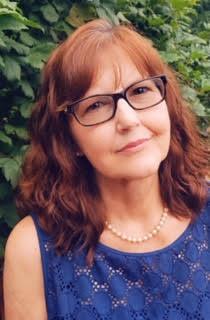

My name is Margaret Rice, and I live in Grants Pass, Oregon.
It was a normal December in 2016 with the Christmas tree decorated, shopping to do, birthday parties to plan for my eldest daughter and son-in-law, wellness checks for two recently adopted kittens, preparations for a grandchildren’s sleepover – all the normal things that kept life humming. My annual visit with my nurse practitioner was on the 6th. She was monitoring my estradiol as it had been climbing, even after stopping the hormone replacement therapy I’d been on since my hysterectomy at age 27. My levels had risen to over 250, which was unusual for a 65 year old woman; so she immediately scheduled an ultrasound for the following Friday, December 15th. After the procedure I had an uneasy feeling that culminated with a phone call from my doctor not 20 minutes later telling me I had a fairly large mass on my left ovary. She thought it could be a benign cyst but wanted me to visit a gynecologist as soon as possible. Being in the midst of the holiday season I couldn’t get an appointment before the 30th. That meant two more weeks of waiting which felt like an eternity.
They sent me two and a half hours north to the Willamette Cancer Institute in Eugene, Oregon to consult with a gynecological oncologist. Surgery was scheduled for January 19th. During the surgery the surgeon performed a complete staging due to early pathology findings. We felt blindsided at my February 1st recheck to learn I had a diagnosis of stage IIB Granulosa Cell Tumor of the Ovary. My family and I had been reassured the day of surgery that everything appeared 99.9% normal. What? Cancer? Yes…a rare (only 2-5%) sex-cord stromal ovarian cancer. Due to its rarity, no one really knows what treatments work best. The tumor board recommended chemotherapy. My surgeon set me up with a local oncologist for a second opinion. This doctor also recommended chemo. His sage words resonated with me – make a decision I could live with, without regret, no matter what the outcome. Still unsure, I chose to get a third opinion at The Cancer Treatment Centers of America. They agreed with the diagnosis, but not the treatment. Radiation of my pelvis and vaginal cuff was recommended because the tumors were adhered to those areas during surgery. By nature I am not indecisive; however, this decision was different. Due to the limited amount of information regarding treatment results, I decided not to have chemotherapy or radiation. I chose to attempt a healthy lifestyle instead. So far I am still NED – no evidence of disease.
GCT can be monitored with CT scans, MRI’s, PET scans, as well as blood tests Inhibin A & B (which some GCT tumors excrete), AMH (anti-mullerian hormone) which would only be found in post-menopausal women due to GCT growth, and estradiol (also excreted by tumors). Statistics I’ve found suggest less than 10% of those diagnosed with stage 1 disease experience recurrence whereas up to 30% of more advanced stages recur up to 30 years following initial diagnosis and treatment. Therefore, every 3 months was punctuated with lab work and scans at the 6 month mark for the first 2 years. I am now monitored every 6 months. Oncologists differ on follow-up treatment being every 6 months, or annually, for life.
I belong to a wonderful group of women in a Facebook group known as the “GCT Survivor Sisters.” Their support, knowledge, care and concern for each other is amazing! In the almost 3 years I’ve been in this group we have lost too many sisters – which is both heartbreaking and astounding for a cancer that is supposedly slow growing. These women give me strength and courage to move forward without worry or fear. Since diagnosis I’ve learned to cherish each and every day. As one of our angel warriors always said, “I choose joy!”
